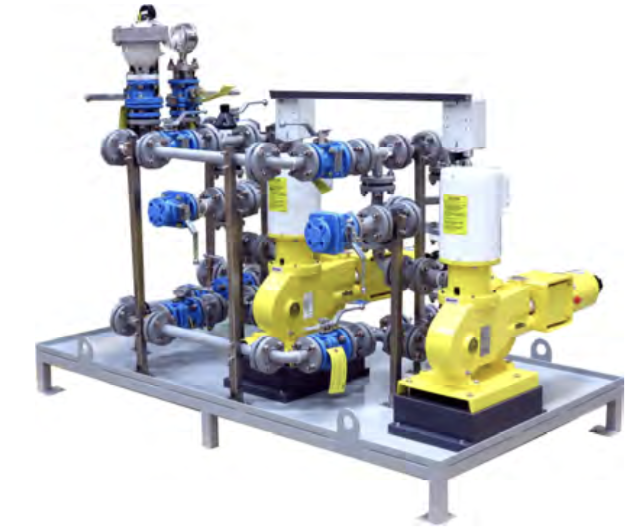For gas and electric utilities, efficiency is the name of the game. Efficiency comes in multiple forms—from consumers being more energy efficient to plants running at optimum efficiency. Today, utilities are working closely with their customers to design and implement energy efficient programs.
When considering the significant capital expenditures (capex) involved in the generation, transmission and distribution of energy to broad customer networks, it is essential that utilities mitigate revenue losses by keeping operating expenses (opex) in check and within approved budgets. Three of the best ways for utilities to boost productivity and optimize efficiency are:
- Enhancing system reliability via asset management strategies
- Minimizing operating costs via monitoring solutions and preventative maintenance
- Managing chemical treatment costs
All three of these initiatives are best accomplished with the help of a Tier 1 business partner that manages every aspect of the supply chain for the customer.
This article describes how a large utility in the Midwest has optimized its operations through such a partnership. This utility services more than 800,000 natural gas customers and almost 500,000 electric customers from a portfolio of hydroelectric, natural gas-powered and some remaining coal plants, which are scheduled to be retrofitted and/or taken out of service in the near future. Each type of plant in this utility’s arsenal relies heavily on water to generate electricity.
Why Water Is Critical to Utilities
There is a direct correlation between the quality of water used to generate steam and a power plant’s efficiency. Power plants consume tremendous volumes of water, which is why most plants are located near surface water. The quality of a plant’s incoming water can vary dramatically,
based on seasonality and weather conditions.
Plants treat water to ensure that it is suitable for operations. To do this, plants rely on chemical feed systems for applications such as disinfection and pH control. Chemical feed systems also dose scale inhibitors and anti-corrosion chemicals to protect piping and process equipment. These applications are critical for optimizing plant efficiency, and also to prevent fouling and condenser performance issues that could hinder plant uptime. The tighter the water quality control, the more efficient the plant—and chemical feed systems are critical to this efficiency.
How Power Plants Treat Water
Power plants, like most industrial plants, treat water via chemical injection skids with highly accurate metering pumps. These pumps inject expensive—and hazardous—chemicals for scale inhibition, corrosion protection and microbiological fouling.
The chemical skids used contain multiple technologies—including metering pumps, monitoring devices, chemical storage tanks, instrumentation, programmable logic controllers (PLCs), and feed verification systems—plus all of the piping required to deliver chemicals to where they are needed.
Asset Management, Safety & Reliability
How do plants keep all of this equipment running safely at peak efficiency? It starts with asset management.
Asset management is primarily comprised of inventory, assessment, refurbishment and deployment. Assets in a plant are expensive, and they frequently fall into disrepair, often times becoming cannibalized for spare parts. To prevent this, a Tier 1 business partner should conduct plant-wide chemical feed system audits that document and photograph each system. They should remove or refurbish equipment as appropriate. The Tier 1 business partner should actively manage these systems, maintaining operating equipment, and redeploying new equipment from a ready inventory when needed.
While managing the health of equipment is important, looking out for the safety of employees is something that should never be overlooked. Having several sets of trained and experienced eyes constantly looking out for safety hazards, or potential issues with rotating equipment, pressurized lines or hazardous chemicals can be the most important benefit a Tier-1 business partner brings to a plant.
If and when new equipment is needed, Computer Aided Design services, such as 3D parametric modeling, AutoCAD conversion, and detailed process and instrumentation diagrams let the user see what they are getting before they buy it. Today’s virtual reality design software enables plant management to virtually walk through their facilities and see how equipment skids will function. The ability to incorporate spacing data into designs minimizes unseen problems down the line. As a result, maintenance personnel know they will have the necessary tool clearances to reach pipes and valves once the skid is installed.
A Tier 1 partner should also be a systems integrator that can stock and supply all the critical items needed, including pumps, valves, fittings, gages, sensors, controllers, tanks and electrical components. They should have immediate access to all pumps and equipment in order to streamline the build and minimize delivery time.
When done correctly, the Tier 1 partnership encompasses the full spectrum—including needs assessment, innovative design, storage, deployment and refurbishment of the chemical feed assets.
Monitoring & Maintenance
For plants that run operations on a 24/7/365 basis, maintaining chemical feed systems is a priority. Monitoring solutions are not only used to adjust chemical injection rates, but also to validate the health of equipment. For utilities that run multiple plants across a wide geographical area, remote monitoring systems are essential.
In today’s world, baby boomers are retiring by the thousands and vast intuitional knowledge retires with them each day. Utilities can mitigate the impact of this reality by outsourcing to experienced Tier 1 partners. While it is virtually impossible to replace generational expertise, it is 
For plant operators, outsourcing monitoring and maintenance activities to a trusted partner brings peace of mind that equipment is working as planned. It also shortens the time required to address emergency maintenance. The ability to dynamically monitor and instantly identify which
systems are working correctly and which pumps are vibrating (or starting to cavitate) enables maintenance teams to plan the day and focus on items that require attention. Data and intuitive reporting help maintenance teams prioritize, and it boosts productivity by ensuring that all service time is allocated where it is most needed.
Predictive maintenance is based on expert knowledge of equipment and the ability to forecast when equipment needs attention or replacement parts. It also relies on historical data that correlates how specific applications function in specific operating environments (i.e., how pumps deal with chemical combinations or how outdoor equipment withstands seasonal climates). The common services found in most predictive maintenance programs include instrumentation calibrations, chemical feed rate calibrations, sensor maintenance, controller maintenance, parts replacement on pumps and emergency repairs when necessary.
Maintenance services provided by Tier 1 suppliers should also include cooling tower cleaning, legionella monitoring, sludge removal, reverse osmosis (RO) membrane cleaning or replacement and more.
Because chemical feed systems are critical to operations, they are typically delivered in redundant configurations with failsafe, automatic switchover capabilities, but these measures cannot completely eliminate productivity losses due to equipment issues and maintenance. The utility described in this story had previously averaged 70 percent of uptime on individual pieces of equipment (prompting them to rotate backup systems regularly). After implementing the monitoring and predictive maintenance programs through a Tier 1 provider, they have been able to increase equipment uptime to 98 percent.
Productivity and profits are not only increased by asset management and predictive maintenance: they are also boosted by effectively managing a plant’s top-line expense, which is the cost of chemicals.
Chemicals Management
Managing chemical costs starts with procurement and supply chain management. It is important to maintain productive relationships with chemical suppliers to ensure a reliable supply for a plant. This guards against ad-hoc or short-term supply disruptions, and it helps to keep prices in check.
The utility described in this story spends $6 million to $7 million dollars annually on chemicals, which is one of their largest expenses (second only to labor).
Chemical management activities are connected to (and influenced by) equipment designs. Properly sized systems ensure that chemicals are metered in the precise amounts required for the job and not wasted. The Tier 1 suppliers that design skids should possess a thorough understanding of industrial water treatment best practices, and they should also be experts in application engineering, project management, controls design, documentation control, quality assurance, and field service.
For utilities that still burn coal (and produce ash waste), numerous environmental regulations mandate specific water treatments. Byproducts such as
When it comes to specialty chemicals, permits and approvals from state agencies are required. These relationships should be managed carefully by Tier 1 partners to ensure there are no delays or disruptions in procuring chemicals for day-to-day operations.
The role a Tier 1 supplier plays in chemical management is critical to helping a power plant save money, and this relationship should also help the utility become a better environmental steward in its community.
If a Tier 1 provider can deliver all the capabilities identified in this article, then it should bring a higher level of efficiency and productivity to the plant, and also deliver the peace of mind that plant operators and management need to sleep well at night, knowing there is a trusted team of first responders available to address any need.




